Care Plan Development: Roper-Logan-Tierney Model Application
VerifiedAdded on 2023/06/04
|9
|2574
|60
Report
AI Summary
This report provides a comprehensive nursing care plan for Ms. Marley, an 80-year-old patient with osteoporosis, hypertension, and a hearing deficit, who is recovering from a fractured femur. The Roper-Logan-Tierney model is utilized to evaluate and address her needs across various activities of living (AOL), specifically focusing on maintaining a secure environment, mobilizing, and sleeping. The care plan includes detailed assessments, interventions, and evaluations aimed at improving Ms. Marley's well-being, preventing falls, managing pain, and promoting adequate rest, ultimately enhancing her recovery and quality of life. The report also emphasizes the importance of considering psychological, environmental, and socio-cultural factors in developing patient-specific care plans, highlighting the role of evaluation in refining healthcare service delivery.
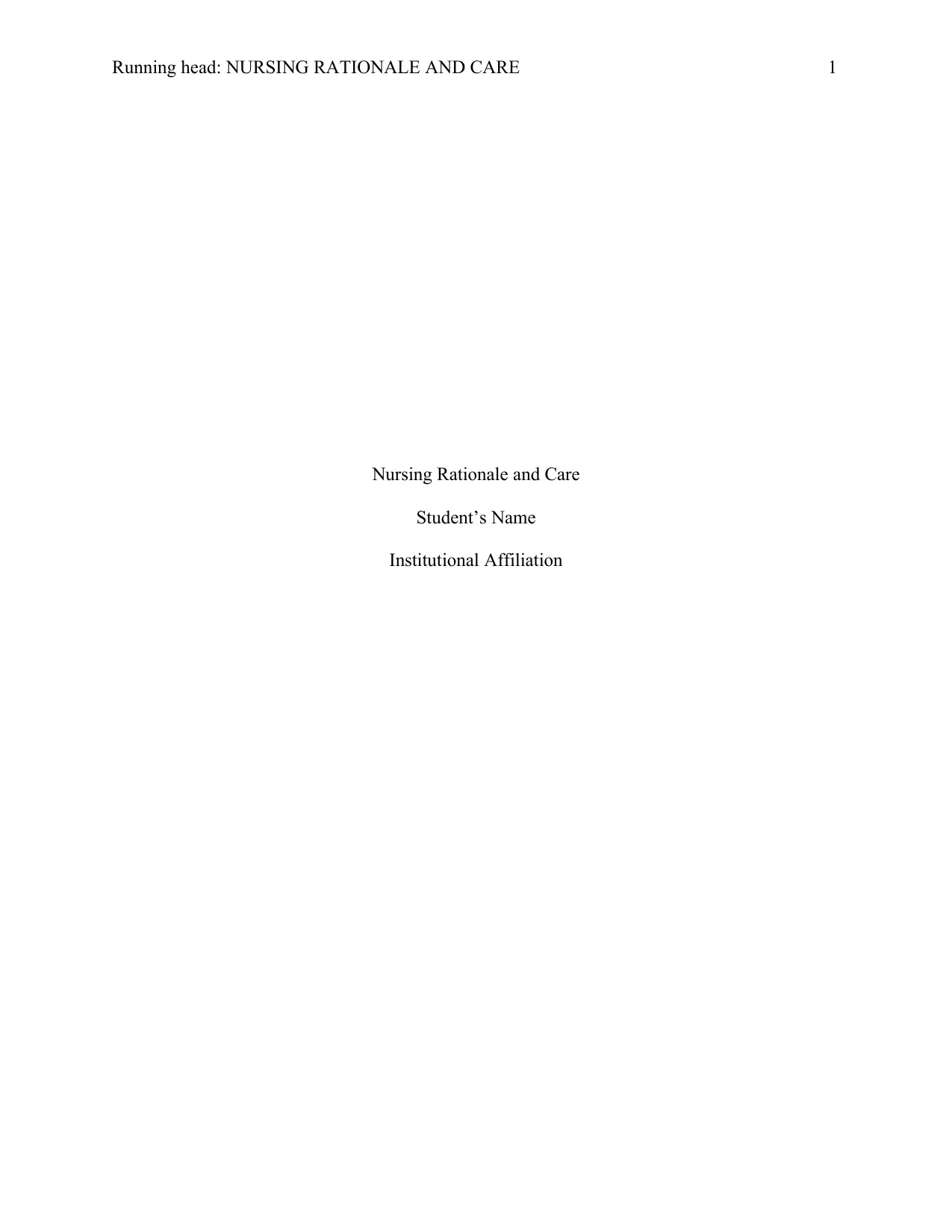
Running head: NURSING RATIONALE AND CARE 1
Nursing Rationale and Care
Student’s Name
Institutional Affiliation
Nursing Rationale and Care
Student’s Name
Institutional Affiliation
Paraphrase This Document
Need a fresh take? Get an instant paraphrase of this document with our AI Paraphraser
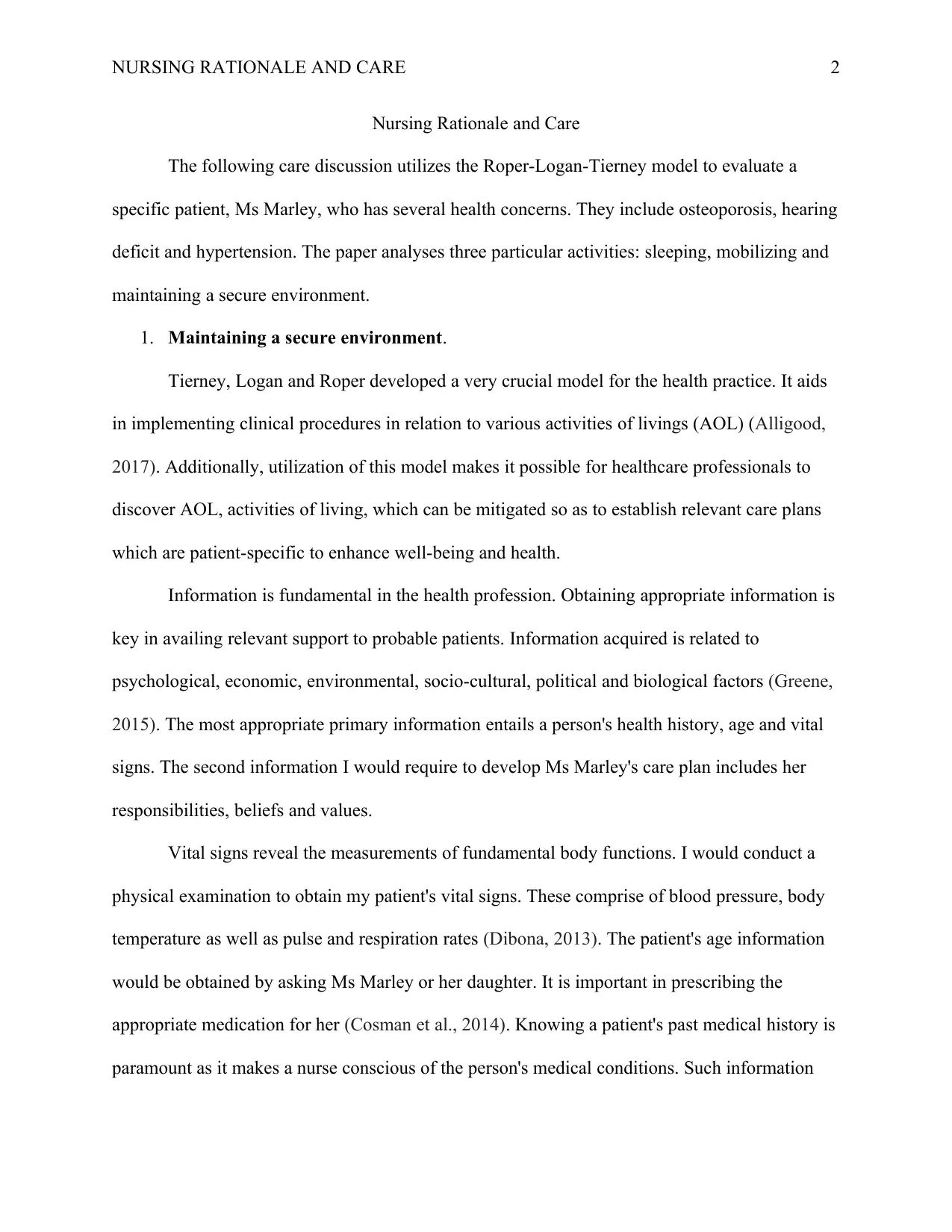
NURSING RATIONALE AND CARE 2
Nursing Rationale and Care
The following care discussion utilizes the Roper-Logan-Tierney model to evaluate a
specific patient, Ms Marley, who has several health concerns. They include osteoporosis, hearing
deficit and hypertension. The paper analyses three particular activities: sleeping, mobilizing and
maintaining a secure environment.
1. Maintaining a secure environment.
Tierney, Logan and Roper developed a very crucial model for the health practice. It aids
in implementing clinical procedures in relation to various activities of livings (AOL) (Alligood,
2017). Additionally, utilization of this model makes it possible for healthcare professionals to
discover AOL, activities of living, which can be mitigated so as to establish relevant care plans
which are patient-specific to enhance well-being and health.
Information is fundamental in the health profession. Obtaining appropriate information is
key in availing relevant support to probable patients. Information acquired is related to
psychological, economic, environmental, socio-cultural, political and biological factors (Greene,
2015). The most appropriate primary information entails a person's health history, age and vital
signs. The second information I would require to develop Ms Marley's care plan includes her
responsibilities, beliefs and values.
Vital signs reveal the measurements of fundamental body functions. I would conduct a
physical examination to obtain my patient's vital signs. These comprise of blood pressure, body
temperature as well as pulse and respiration rates (Dibona, 2013). The patient's age information
would be obtained by asking Ms Marley or her daughter. It is important in prescribing the
appropriate medication for her (Cosman et al., 2014). Knowing a patient's past medical history is
paramount as it makes a nurse conscious of the person's medical conditions. Such information
Nursing Rationale and Care
The following care discussion utilizes the Roper-Logan-Tierney model to evaluate a
specific patient, Ms Marley, who has several health concerns. They include osteoporosis, hearing
deficit and hypertension. The paper analyses three particular activities: sleeping, mobilizing and
maintaining a secure environment.
1. Maintaining a secure environment.
Tierney, Logan and Roper developed a very crucial model for the health practice. It aids
in implementing clinical procedures in relation to various activities of livings (AOL) (Alligood,
2017). Additionally, utilization of this model makes it possible for healthcare professionals to
discover AOL, activities of living, which can be mitigated so as to establish relevant care plans
which are patient-specific to enhance well-being and health.
Information is fundamental in the health profession. Obtaining appropriate information is
key in availing relevant support to probable patients. Information acquired is related to
psychological, economic, environmental, socio-cultural, political and biological factors (Greene,
2015). The most appropriate primary information entails a person's health history, age and vital
signs. The second information I would require to develop Ms Marley's care plan includes her
responsibilities, beliefs and values.
Vital signs reveal the measurements of fundamental body functions. I would conduct a
physical examination to obtain my patient's vital signs. These comprise of blood pressure, body
temperature as well as pulse and respiration rates (Dibona, 2013). The patient's age information
would be obtained by asking Ms Marley or her daughter. It is important in prescribing the
appropriate medication for her (Cosman et al., 2014). Knowing a patient's past medical history is
paramount as it makes a nurse conscious of the person's medical conditions. Such information
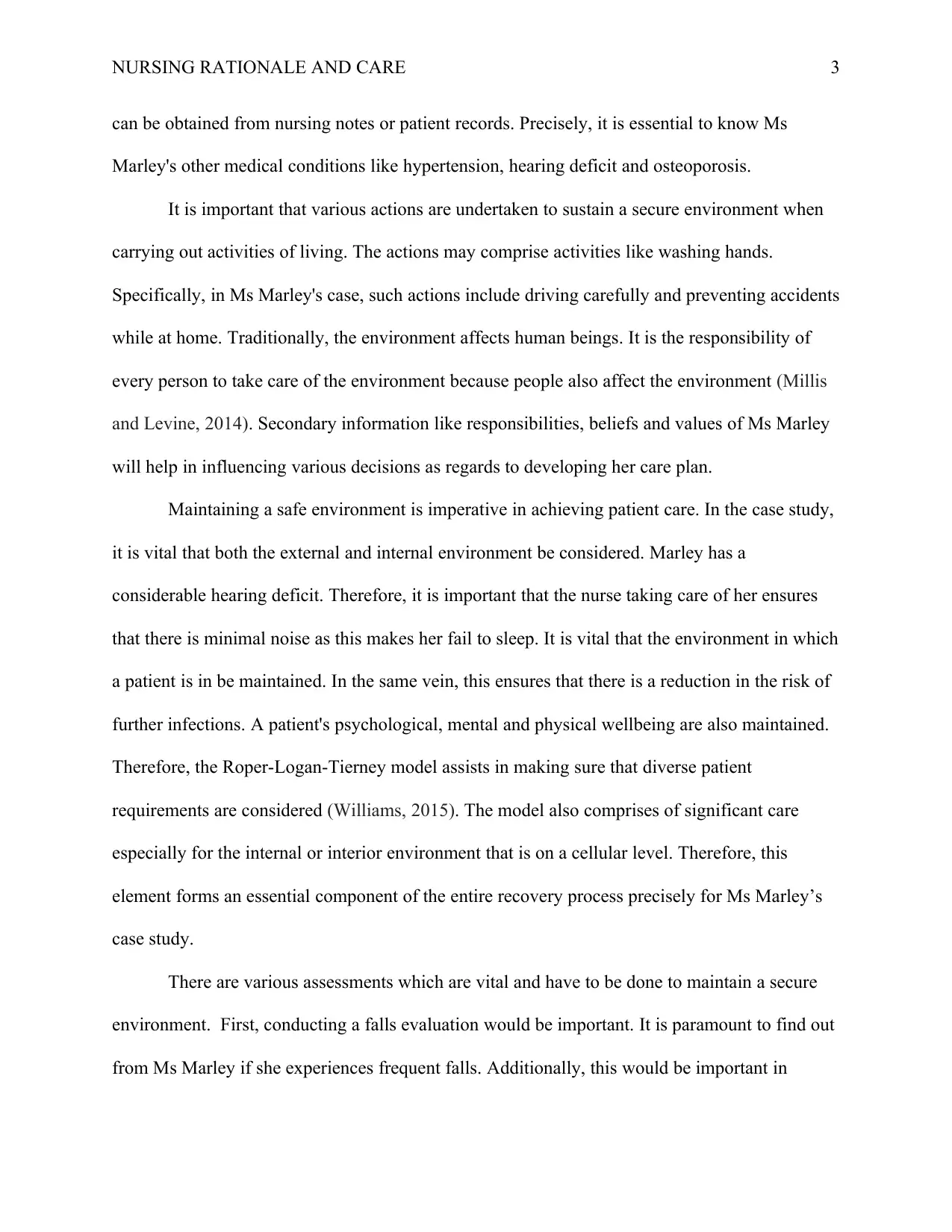
NURSING RATIONALE AND CARE 3
can be obtained from nursing notes or patient records. Precisely, it is essential to know Ms
Marley's other medical conditions like hypertension, hearing deficit and osteoporosis.
It is important that various actions are undertaken to sustain a secure environment when
carrying out activities of living. The actions may comprise activities like washing hands.
Specifically, in Ms Marley's case, such actions include driving carefully and preventing accidents
while at home. Traditionally, the environment affects human beings. It is the responsibility of
every person to take care of the environment because people also affect the environment (Millis
and Levine, 2014). Secondary information like responsibilities, beliefs and values of Ms Marley
will help in influencing various decisions as regards to developing her care plan.
Maintaining a safe environment is imperative in achieving patient care. In the case study,
it is vital that both the external and internal environment be considered. Marley has a
considerable hearing deficit. Therefore, it is important that the nurse taking care of her ensures
that there is minimal noise as this makes her fail to sleep. It is vital that the environment in which
a patient is in be maintained. In the same vein, this ensures that there is a reduction in the risk of
further infections. A patient's psychological, mental and physical wellbeing are also maintained.
Therefore, the Roper-Logan-Tierney model assists in making sure that diverse patient
requirements are considered (Williams, 2015). The model also comprises of significant care
especially for the internal or interior environment that is on a cellular level. Therefore, this
element forms an essential component of the entire recovery process precisely for Ms Marley’s
case study.
There are various assessments which are vital and have to be done to maintain a secure
environment. First, conducting a falls evaluation would be important. It is paramount to find out
from Ms Marley if she experiences frequent falls. Additionally, this would be important in
can be obtained from nursing notes or patient records. Precisely, it is essential to know Ms
Marley's other medical conditions like hypertension, hearing deficit and osteoporosis.
It is important that various actions are undertaken to sustain a secure environment when
carrying out activities of living. The actions may comprise activities like washing hands.
Specifically, in Ms Marley's case, such actions include driving carefully and preventing accidents
while at home. Traditionally, the environment affects human beings. It is the responsibility of
every person to take care of the environment because people also affect the environment (Millis
and Levine, 2014). Secondary information like responsibilities, beliefs and values of Ms Marley
will help in influencing various decisions as regards to developing her care plan.
Maintaining a safe environment is imperative in achieving patient care. In the case study,
it is vital that both the external and internal environment be considered. Marley has a
considerable hearing deficit. Therefore, it is important that the nurse taking care of her ensures
that there is minimal noise as this makes her fail to sleep. It is vital that the environment in which
a patient is in be maintained. In the same vein, this ensures that there is a reduction in the risk of
further infections. A patient's psychological, mental and physical wellbeing are also maintained.
Therefore, the Roper-Logan-Tierney model assists in making sure that diverse patient
requirements are considered (Williams, 2015). The model also comprises of significant care
especially for the internal or interior environment that is on a cellular level. Therefore, this
element forms an essential component of the entire recovery process precisely for Ms Marley’s
case study.
There are various assessments which are vital and have to be done to maintain a secure
environment. First, conducting a falls evaluation would be important. It is paramount to find out
from Ms Marley if she experiences frequent falls. Additionally, this would be important in
⊘ This is a preview!⊘
Do you want full access?
Subscribe today to unlock all pages.

Trusted by 1+ million students worldwide
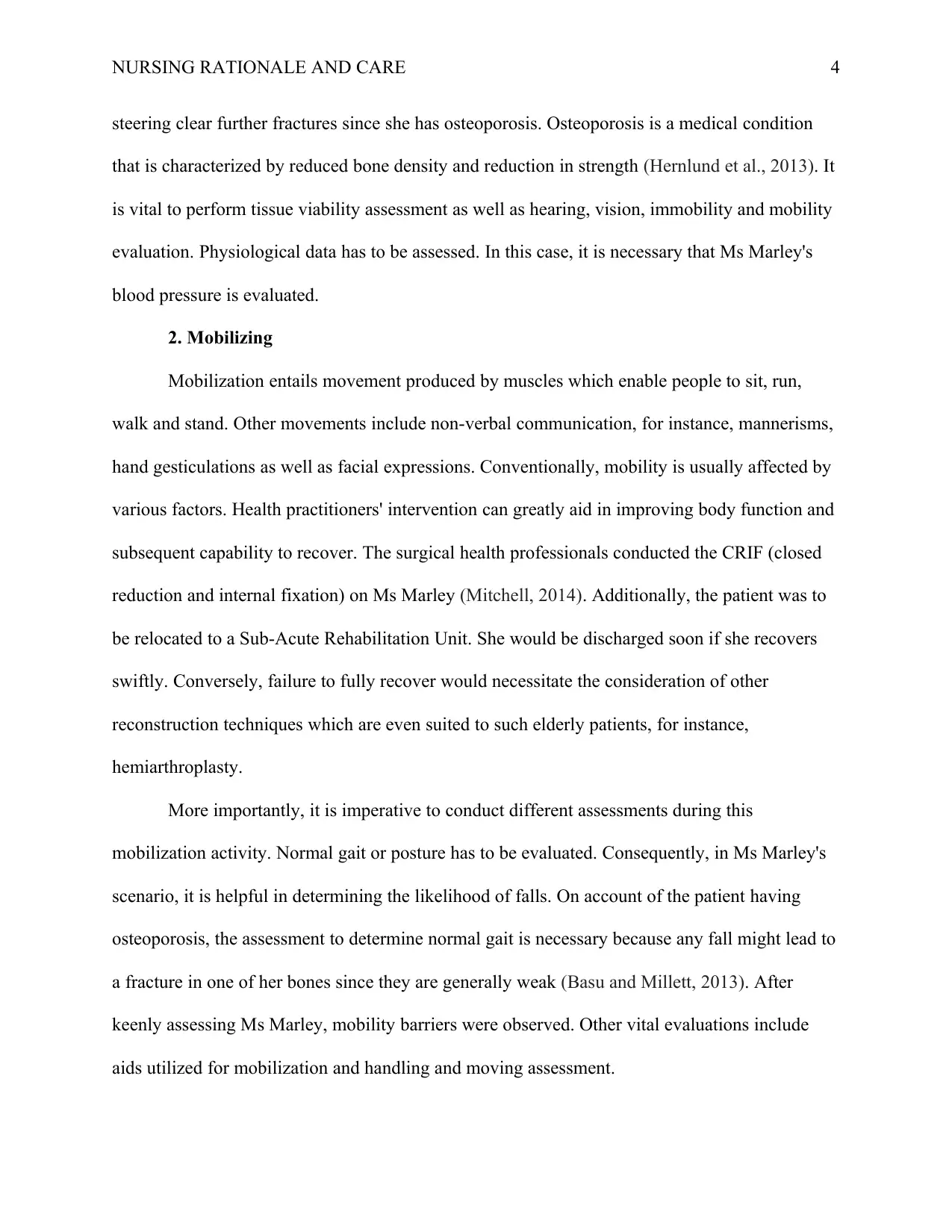
NURSING RATIONALE AND CARE 4
steering clear further fractures since she has osteoporosis. Osteoporosis is a medical condition
that is characterized by reduced bone density and reduction in strength (Hernlund et al., 2013). It
is vital to perform tissue viability assessment as well as hearing, vision, immobility and mobility
evaluation. Physiological data has to be assessed. In this case, it is necessary that Ms Marley's
blood pressure is evaluated.
2. Mobilizing
Mobilization entails movement produced by muscles which enable people to sit, run,
walk and stand. Other movements include non-verbal communication, for instance, mannerisms,
hand gesticulations as well as facial expressions. Conventionally, mobility is usually affected by
various factors. Health practitioners' intervention can greatly aid in improving body function and
subsequent capability to recover. The surgical health professionals conducted the CRIF (closed
reduction and internal fixation) on Ms Marley (Mitchell, 2014). Additionally, the patient was to
be relocated to a Sub-Acute Rehabilitation Unit. She would be discharged soon if she recovers
swiftly. Conversely, failure to fully recover would necessitate the consideration of other
reconstruction techniques which are even suited to such elderly patients, for instance,
hemiarthroplasty.
More importantly, it is imperative to conduct different assessments during this
mobilization activity. Normal gait or posture has to be evaluated. Consequently, in Ms Marley's
scenario, it is helpful in determining the likelihood of falls. On account of the patient having
osteoporosis, the assessment to determine normal gait is necessary because any fall might lead to
a fracture in one of her bones since they are generally weak (Basu and Millett, 2013). After
keenly assessing Ms Marley, mobility barriers were observed. Other vital evaluations include
aids utilized for mobilization and handling and moving assessment.
steering clear further fractures since she has osteoporosis. Osteoporosis is a medical condition
that is characterized by reduced bone density and reduction in strength (Hernlund et al., 2013). It
is vital to perform tissue viability assessment as well as hearing, vision, immobility and mobility
evaluation. Physiological data has to be assessed. In this case, it is necessary that Ms Marley's
blood pressure is evaluated.
2. Mobilizing
Mobilization entails movement produced by muscles which enable people to sit, run,
walk and stand. Other movements include non-verbal communication, for instance, mannerisms,
hand gesticulations as well as facial expressions. Conventionally, mobility is usually affected by
various factors. Health practitioners' intervention can greatly aid in improving body function and
subsequent capability to recover. The surgical health professionals conducted the CRIF (closed
reduction and internal fixation) on Ms Marley (Mitchell, 2014). Additionally, the patient was to
be relocated to a Sub-Acute Rehabilitation Unit. She would be discharged soon if she recovers
swiftly. Conversely, failure to fully recover would necessitate the consideration of other
reconstruction techniques which are even suited to such elderly patients, for instance,
hemiarthroplasty.
More importantly, it is imperative to conduct different assessments during this
mobilization activity. Normal gait or posture has to be evaluated. Consequently, in Ms Marley's
scenario, it is helpful in determining the likelihood of falls. On account of the patient having
osteoporosis, the assessment to determine normal gait is necessary because any fall might lead to
a fracture in one of her bones since they are generally weak (Basu and Millett, 2013). After
keenly assessing Ms Marley, mobility barriers were observed. Other vital evaluations include
aids utilized for mobilization and handling and moving assessment.
Paraphrase This Document
Need a fresh take? Get an instant paraphrase of this document with our AI Paraphraser
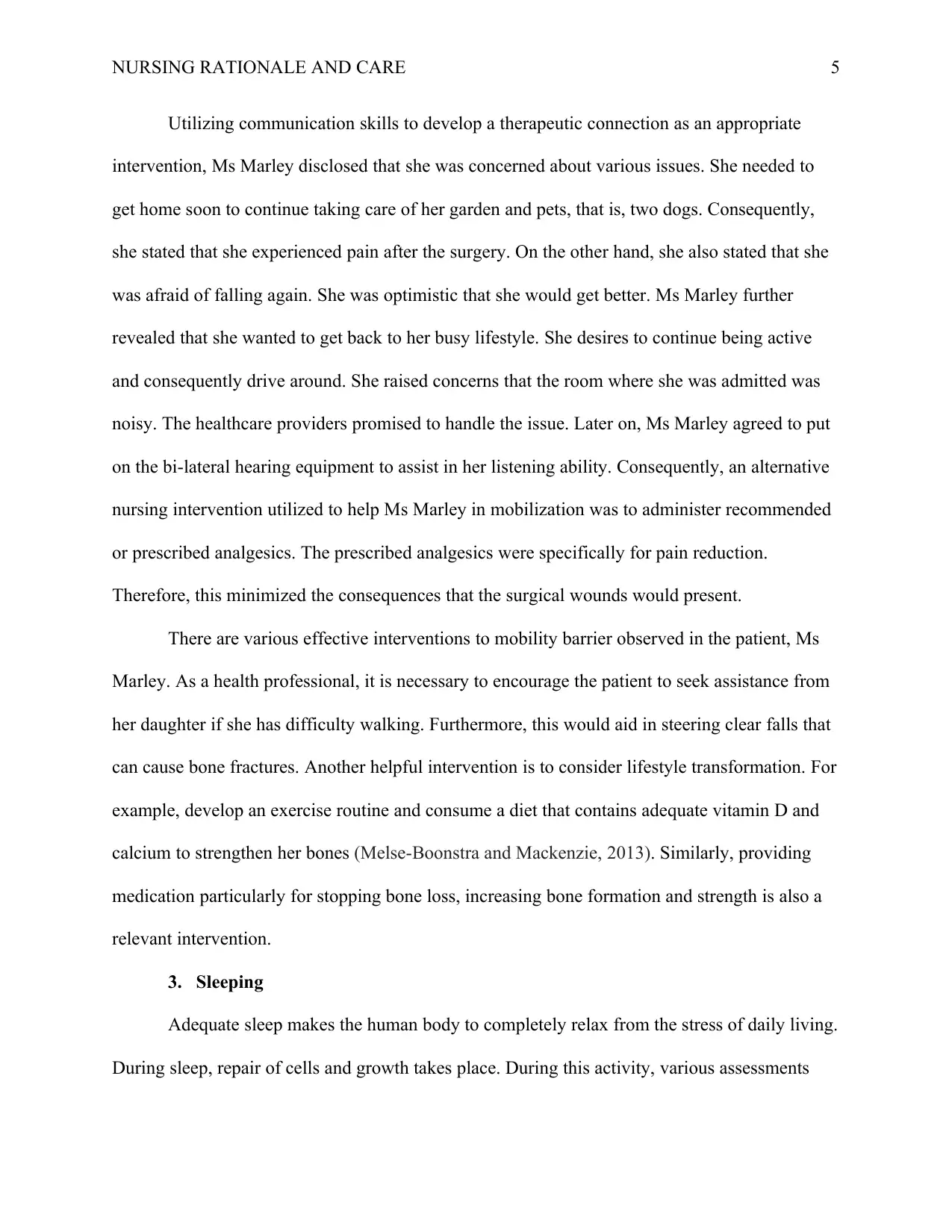
NURSING RATIONALE AND CARE 5
Utilizing communication skills to develop a therapeutic connection as an appropriate
intervention, Ms Marley disclosed that she was concerned about various issues. She needed to
get home soon to continue taking care of her garden and pets, that is, two dogs. Consequently,
she stated that she experienced pain after the surgery. On the other hand, she also stated that she
was afraid of falling again. She was optimistic that she would get better. Ms Marley further
revealed that she wanted to get back to her busy lifestyle. She desires to continue being active
and consequently drive around. She raised concerns that the room where she was admitted was
noisy. The healthcare providers promised to handle the issue. Later on, Ms Marley agreed to put
on the bi-lateral hearing equipment to assist in her listening ability. Consequently, an alternative
nursing intervention utilized to help Ms Marley in mobilization was to administer recommended
or prescribed analgesics. The prescribed analgesics were specifically for pain reduction.
Therefore, this minimized the consequences that the surgical wounds would present.
There are various effective interventions to mobility barrier observed in the patient, Ms
Marley. As a health professional, it is necessary to encourage the patient to seek assistance from
her daughter if she has difficulty walking. Furthermore, this would aid in steering clear falls that
can cause bone fractures. Another helpful intervention is to consider lifestyle transformation. For
example, develop an exercise routine and consume a diet that contains adequate vitamin D and
calcium to strengthen her bones (Melse-Boonstra and Mackenzie, 2013). Similarly, providing
medication particularly for stopping bone loss, increasing bone formation and strength is also a
relevant intervention.
3. Sleeping
Adequate sleep makes the human body to completely relax from the stress of daily living.
During sleep, repair of cells and growth takes place. During this activity, various assessments
Utilizing communication skills to develop a therapeutic connection as an appropriate
intervention, Ms Marley disclosed that she was concerned about various issues. She needed to
get home soon to continue taking care of her garden and pets, that is, two dogs. Consequently,
she stated that she experienced pain after the surgery. On the other hand, she also stated that she
was afraid of falling again. She was optimistic that she would get better. Ms Marley further
revealed that she wanted to get back to her busy lifestyle. She desires to continue being active
and consequently drive around. She raised concerns that the room where she was admitted was
noisy. The healthcare providers promised to handle the issue. Later on, Ms Marley agreed to put
on the bi-lateral hearing equipment to assist in her listening ability. Consequently, an alternative
nursing intervention utilized to help Ms Marley in mobilization was to administer recommended
or prescribed analgesics. The prescribed analgesics were specifically for pain reduction.
Therefore, this minimized the consequences that the surgical wounds would present.
There are various effective interventions to mobility barrier observed in the patient, Ms
Marley. As a health professional, it is necessary to encourage the patient to seek assistance from
her daughter if she has difficulty walking. Furthermore, this would aid in steering clear falls that
can cause bone fractures. Another helpful intervention is to consider lifestyle transformation. For
example, develop an exercise routine and consume a diet that contains adequate vitamin D and
calcium to strengthen her bones (Melse-Boonstra and Mackenzie, 2013). Similarly, providing
medication particularly for stopping bone loss, increasing bone formation and strength is also a
relevant intervention.
3. Sleeping
Adequate sleep makes the human body to completely relax from the stress of daily living.
During sleep, repair of cells and growth takes place. During this activity, various assessments
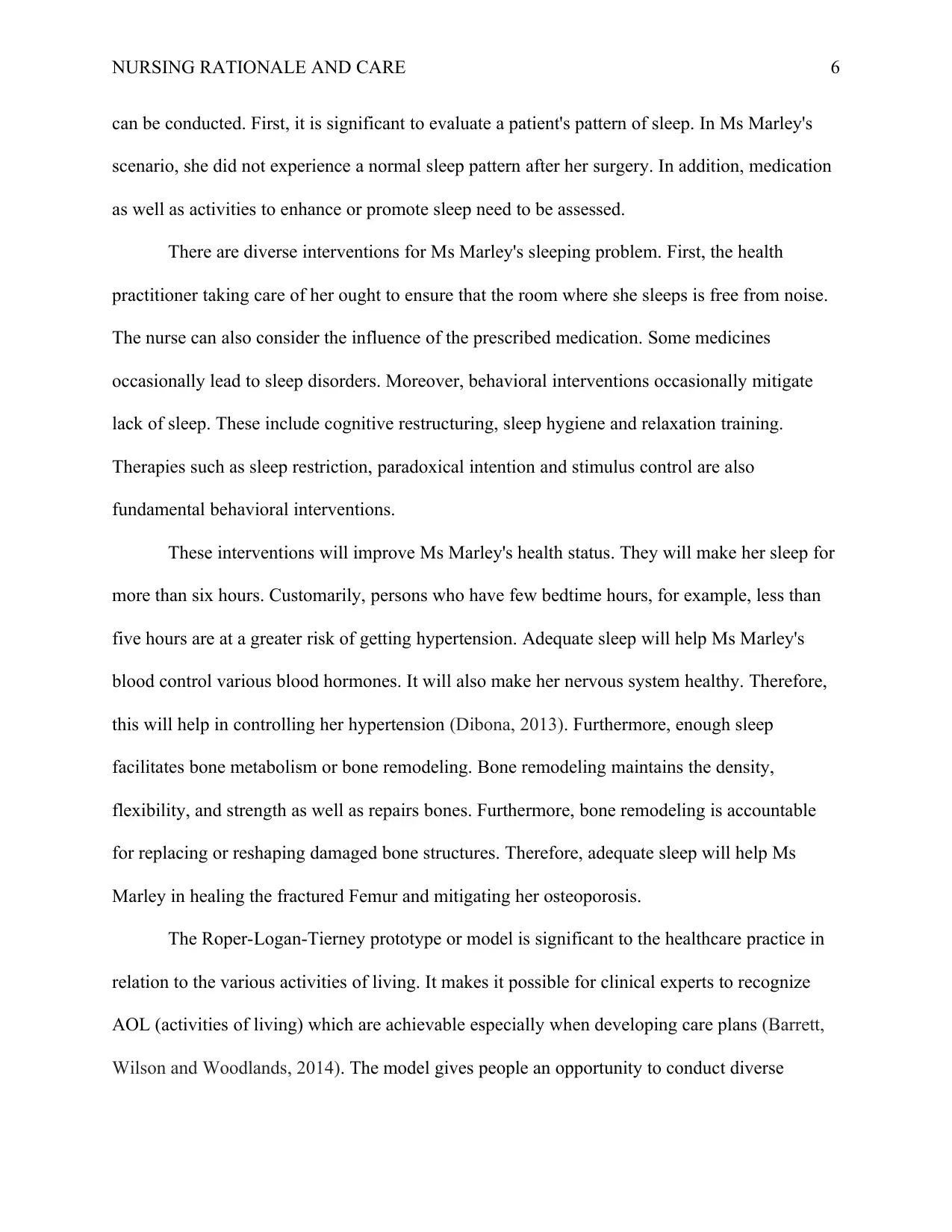
NURSING RATIONALE AND CARE 6
can be conducted. First, it is significant to evaluate a patient's pattern of sleep. In Ms Marley's
scenario, she did not experience a normal sleep pattern after her surgery. In addition, medication
as well as activities to enhance or promote sleep need to be assessed.
There are diverse interventions for Ms Marley's sleeping problem. First, the health
practitioner taking care of her ought to ensure that the room where she sleeps is free from noise.
The nurse can also consider the influence of the prescribed medication. Some medicines
occasionally lead to sleep disorders. Moreover, behavioral interventions occasionally mitigate
lack of sleep. These include cognitive restructuring, sleep hygiene and relaxation training.
Therapies such as sleep restriction, paradoxical intention and stimulus control are also
fundamental behavioral interventions.
These interventions will improve Ms Marley's health status. They will make her sleep for
more than six hours. Customarily, persons who have few bedtime hours, for example, less than
five hours are at a greater risk of getting hypertension. Adequate sleep will help Ms Marley's
blood control various blood hormones. It will also make her nervous system healthy. Therefore,
this will help in controlling her hypertension (Dibona, 2013). Furthermore, enough sleep
facilitates bone metabolism or bone remodeling. Bone remodeling maintains the density,
flexibility, and strength as well as repairs bones. Furthermore, bone remodeling is accountable
for replacing or reshaping damaged bone structures. Therefore, adequate sleep will help Ms
Marley in healing the fractured Femur and mitigating her osteoporosis.
The Roper-Logan-Tierney prototype or model is significant to the healthcare practice in
relation to the various activities of living. It makes it possible for clinical experts to recognize
AOL (activities of living) which are achievable especially when developing care plans (Barrett,
Wilson and Woodlands, 2014). The model gives people an opportunity to conduct diverse
can be conducted. First, it is significant to evaluate a patient's pattern of sleep. In Ms Marley's
scenario, she did not experience a normal sleep pattern after her surgery. In addition, medication
as well as activities to enhance or promote sleep need to be assessed.
There are diverse interventions for Ms Marley's sleeping problem. First, the health
practitioner taking care of her ought to ensure that the room where she sleeps is free from noise.
The nurse can also consider the influence of the prescribed medication. Some medicines
occasionally lead to sleep disorders. Moreover, behavioral interventions occasionally mitigate
lack of sleep. These include cognitive restructuring, sleep hygiene and relaxation training.
Therapies such as sleep restriction, paradoxical intention and stimulus control are also
fundamental behavioral interventions.
These interventions will improve Ms Marley's health status. They will make her sleep for
more than six hours. Customarily, persons who have few bedtime hours, for example, less than
five hours are at a greater risk of getting hypertension. Adequate sleep will help Ms Marley's
blood control various blood hormones. It will also make her nervous system healthy. Therefore,
this will help in controlling her hypertension (Dibona, 2013). Furthermore, enough sleep
facilitates bone metabolism or bone remodeling. Bone remodeling maintains the density,
flexibility, and strength as well as repairs bones. Furthermore, bone remodeling is accountable
for replacing or reshaping damaged bone structures. Therefore, adequate sleep will help Ms
Marley in healing the fractured Femur and mitigating her osteoporosis.
The Roper-Logan-Tierney prototype or model is significant to the healthcare practice in
relation to the various activities of living. It makes it possible for clinical experts to recognize
AOL (activities of living) which are achievable especially when developing care plans (Barrett,
Wilson and Woodlands, 2014). The model gives people an opportunity to conduct diverse
⊘ This is a preview!⊘
Do you want full access?
Subscribe today to unlock all pages.

Trusted by 1+ million students worldwide
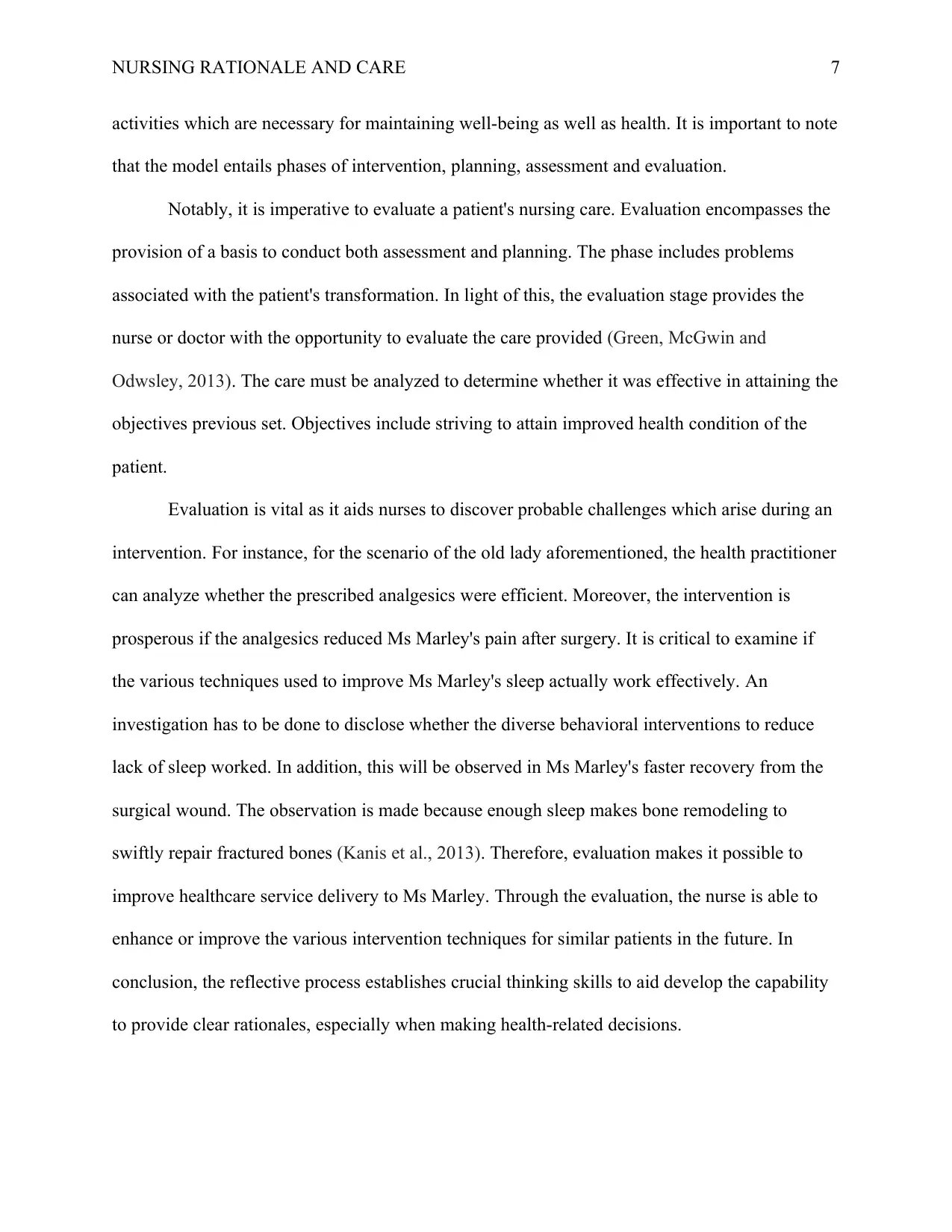
NURSING RATIONALE AND CARE 7
activities which are necessary for maintaining well-being as well as health. It is important to note
that the model entails phases of intervention, planning, assessment and evaluation.
Notably, it is imperative to evaluate a patient's nursing care. Evaluation encompasses the
provision of a basis to conduct both assessment and planning. The phase includes problems
associated with the patient's transformation. In light of this, the evaluation stage provides the
nurse or doctor with the opportunity to evaluate the care provided (Green, McGwin and
Odwsley, 2013). The care must be analyzed to determine whether it was effective in attaining the
objectives previous set. Objectives include striving to attain improved health condition of the
patient.
Evaluation is vital as it aids nurses to discover probable challenges which arise during an
intervention. For instance, for the scenario of the old lady aforementioned, the health practitioner
can analyze whether the prescribed analgesics were efficient. Moreover, the intervention is
prosperous if the analgesics reduced Ms Marley's pain after surgery. It is critical to examine if
the various techniques used to improve Ms Marley's sleep actually work effectively. An
investigation has to be done to disclose whether the diverse behavioral interventions to reduce
lack of sleep worked. In addition, this will be observed in Ms Marley's faster recovery from the
surgical wound. The observation is made because enough sleep makes bone remodeling to
swiftly repair fractured bones (Kanis et al., 2013). Therefore, evaluation makes it possible to
improve healthcare service delivery to Ms Marley. Through the evaluation, the nurse is able to
enhance or improve the various intervention techniques for similar patients in the future. In
conclusion, the reflective process establishes crucial thinking skills to aid develop the capability
to provide clear rationales, especially when making health-related decisions.
activities which are necessary for maintaining well-being as well as health. It is important to note
that the model entails phases of intervention, planning, assessment and evaluation.
Notably, it is imperative to evaluate a patient's nursing care. Evaluation encompasses the
provision of a basis to conduct both assessment and planning. The phase includes problems
associated with the patient's transformation. In light of this, the evaluation stage provides the
nurse or doctor with the opportunity to evaluate the care provided (Green, McGwin and
Odwsley, 2013). The care must be analyzed to determine whether it was effective in attaining the
objectives previous set. Objectives include striving to attain improved health condition of the
patient.
Evaluation is vital as it aids nurses to discover probable challenges which arise during an
intervention. For instance, for the scenario of the old lady aforementioned, the health practitioner
can analyze whether the prescribed analgesics were efficient. Moreover, the intervention is
prosperous if the analgesics reduced Ms Marley's pain after surgery. It is critical to examine if
the various techniques used to improve Ms Marley's sleep actually work effectively. An
investigation has to be done to disclose whether the diverse behavioral interventions to reduce
lack of sleep worked. In addition, this will be observed in Ms Marley's faster recovery from the
surgical wound. The observation is made because enough sleep makes bone remodeling to
swiftly repair fractured bones (Kanis et al., 2013). Therefore, evaluation makes it possible to
improve healthcare service delivery to Ms Marley. Through the evaluation, the nurse is able to
enhance or improve the various intervention techniques for similar patients in the future. In
conclusion, the reflective process establishes crucial thinking skills to aid develop the capability
to provide clear rationales, especially when making health-related decisions.
Paraphrase This Document
Need a fresh take? Get an instant paraphrase of this document with our AI Paraphraser
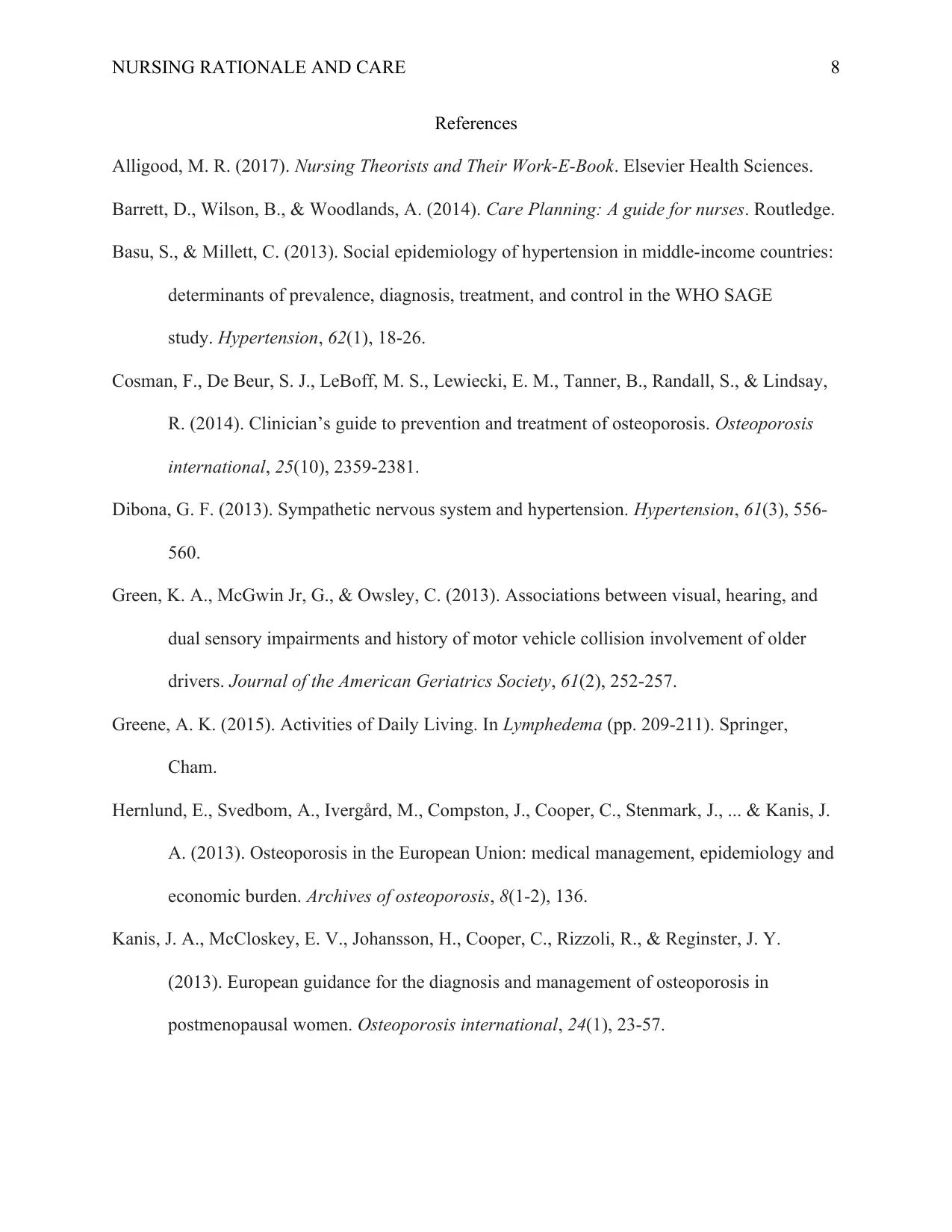
NURSING RATIONALE AND CARE 8
References
Alligood, M. R. (2017). Nursing Theorists and Their Work-E-Book. Elsevier Health Sciences.
Barrett, D., Wilson, B., & Woodlands, A. (2014). Care Planning: A guide for nurses. Routledge.
Basu, S., & Millett, C. (2013). Social epidemiology of hypertension in middle-income countries:
determinants of prevalence, diagnosis, treatment, and control in the WHO SAGE
study. Hypertension, 62(1), 18-26.
Cosman, F., De Beur, S. J., LeBoff, M. S., Lewiecki, E. M., Tanner, B., Randall, S., & Lindsay,
R. (2014). Clinician’s guide to prevention and treatment of osteoporosis. Osteoporosis
international, 25(10), 2359-2381.
Dibona, G. F. (2013). Sympathetic nervous system and hypertension. Hypertension, 61(3), 556-
560.
Green, K. A., McGwin Jr, G., & Owsley, C. (2013). Associations between visual, hearing, and
dual sensory impairments and history of motor vehicle collision involvement of older
drivers. Journal of the American Geriatrics Society, 61(2), 252-257.
Greene, A. K. (2015). Activities of Daily Living. In Lymphedema (pp. 209-211). Springer,
Cham.
Hernlund, E., Svedbom, A., Ivergård, M., Compston, J., Cooper, C., Stenmark, J., ... & Kanis, J.
A. (2013). Osteoporosis in the European Union: medical management, epidemiology and
economic burden. Archives of osteoporosis, 8(1-2), 136.
Kanis, J. A., McCloskey, E. V., Johansson, H., Cooper, C., Rizzoli, R., & Reginster, J. Y.
(2013). European guidance for the diagnosis and management of osteoporosis in
postmenopausal women. Osteoporosis international, 24(1), 23-57.
References
Alligood, M. R. (2017). Nursing Theorists and Their Work-E-Book. Elsevier Health Sciences.
Barrett, D., Wilson, B., & Woodlands, A. (2014). Care Planning: A guide for nurses. Routledge.
Basu, S., & Millett, C. (2013). Social epidemiology of hypertension in middle-income countries:
determinants of prevalence, diagnosis, treatment, and control in the WHO SAGE
study. Hypertension, 62(1), 18-26.
Cosman, F., De Beur, S. J., LeBoff, M. S., Lewiecki, E. M., Tanner, B., Randall, S., & Lindsay,
R. (2014). Clinician’s guide to prevention and treatment of osteoporosis. Osteoporosis
international, 25(10), 2359-2381.
Dibona, G. F. (2013). Sympathetic nervous system and hypertension. Hypertension, 61(3), 556-
560.
Green, K. A., McGwin Jr, G., & Owsley, C. (2013). Associations between visual, hearing, and
dual sensory impairments and history of motor vehicle collision involvement of older
drivers. Journal of the American Geriatrics Society, 61(2), 252-257.
Greene, A. K. (2015). Activities of Daily Living. In Lymphedema (pp. 209-211). Springer,
Cham.
Hernlund, E., Svedbom, A., Ivergård, M., Compston, J., Cooper, C., Stenmark, J., ... & Kanis, J.
A. (2013). Osteoporosis in the European Union: medical management, epidemiology and
economic burden. Archives of osteoporosis, 8(1-2), 136.
Kanis, J. A., McCloskey, E. V., Johansson, H., Cooper, C., Rizzoli, R., & Reginster, J. Y.
(2013). European guidance for the diagnosis and management of osteoporosis in
postmenopausal women. Osteoporosis international, 24(1), 23-57.
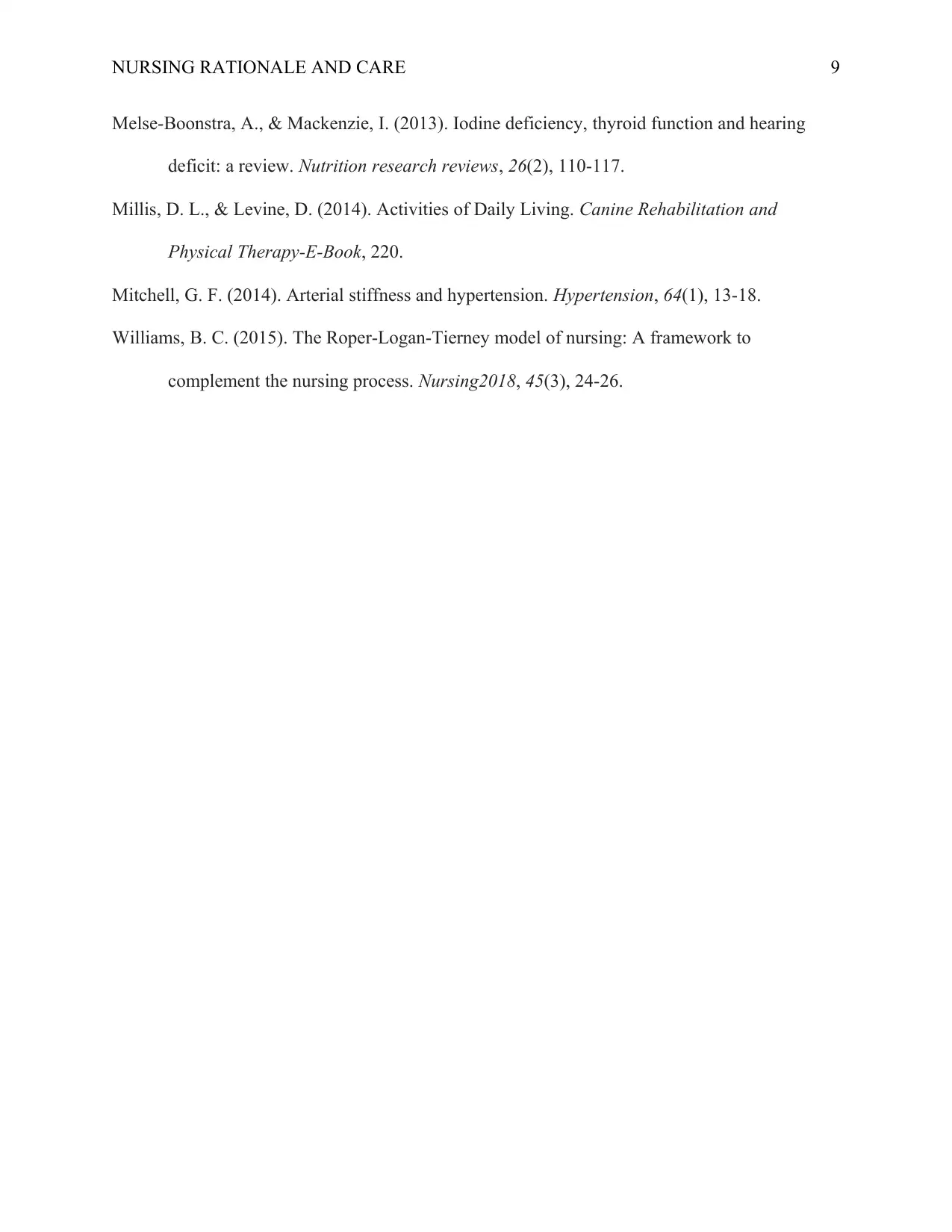
NURSING RATIONALE AND CARE 9
Melse-Boonstra, A., & Mackenzie, I. (2013). Iodine deficiency, thyroid function and hearing
deficit: a review. Nutrition research reviews, 26(2), 110-117.
Millis, D. L., & Levine, D. (2014). Activities of Daily Living. Canine Rehabilitation and
Physical Therapy-E-Book, 220.
Mitchell, G. F. (2014). Arterial stiffness and hypertension. Hypertension, 64(1), 13-18.
Williams, B. C. (2015). The Roper-Logan-Tierney model of nursing: A framework to
complement the nursing process. Nursing2018, 45(3), 24-26.
Melse-Boonstra, A., & Mackenzie, I. (2013). Iodine deficiency, thyroid function and hearing
deficit: a review. Nutrition research reviews, 26(2), 110-117.
Millis, D. L., & Levine, D. (2014). Activities of Daily Living. Canine Rehabilitation and
Physical Therapy-E-Book, 220.
Mitchell, G. F. (2014). Arterial stiffness and hypertension. Hypertension, 64(1), 13-18.
Williams, B. C. (2015). The Roper-Logan-Tierney model of nursing: A framework to
complement the nursing process. Nursing2018, 45(3), 24-26.
⊘ This is a preview!⊘
Do you want full access?
Subscribe today to unlock all pages.

Trusted by 1+ million students worldwide
1 out of 9
Related Documents
Your All-in-One AI-Powered Toolkit for Academic Success.
+13062052269
info@desklib.com
Available 24*7 on WhatsApp / Email
![[object Object]](/_next/static/media/star-bottom.7253800d.svg)
Unlock your academic potential
Copyright © 2020–2025 A2Z Services. All Rights Reserved. Developed and managed by ZUCOL.




